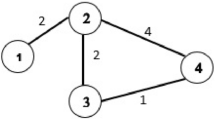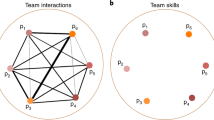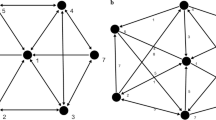Abstract
Objectives
To estimate the effects of team-mate shared experience on overall team performance as well as to determine whether concentration of time together among subgroups of players and/or focal players enhances team performance.
Methods
Social network analysis (SNA) was used to model 30 active Major League Baseball teams from 2006 to 2015 with years of experience together connecting players resulting in 300 individual team networks. Social network metrics of network density, network centralization, and average weighted degree were computed and analyzed with team attributes by generalized least squares regression to predict wins, and team rank. Logistic regression was used to predict binary outcomes of world series and division wins.
Results
Network density was negatively associated with team rank (β = − 0.115, p = .05), while average weighted degree was positively associated with team rank (β = 0.147, p = .01). On average, each extra year of shared player time per team was associated with 14.86% higher probability of winning a division title (B = 2.69, exp(B) = 14.86, p = .05). Each extra shared year of infield membership among team-mates predicted 2.4% lower odds of winning the world series (B = −0.024, exp(B) = 0.976, p = .01), and each extra shared year between outfield players predicted 2.9% lower probability of winning a team’s division (B = −0.029. exp(B) = 0.972, p = .05).
Conclusions
Prolonged shared time between players is beneficial when it is spread evenly among all players of the team, whereas having few focal players who have been on a team together for many years is a disadvantage to overall performance.

Similar content being viewed by others
Data Availability
The data that support the findings of this study are available from Sean Lahman’s Baseball Archive at http://www.seanlahman.com/baseball-archive/statistics.
Notes
In a network where links are undirected, in other words, links between players are reciprocal, there are a total of n possible number between n players. Network density is the sum of all k ties between players team (wk) divided by the potential number of ties between players, n.
\({\text{Density }} = \frac{{{\sum }w_{k} }}{n}.\)
Centralization is the sum of differences between the most central node and all other nodes divided by the sum of the maximum possible difference. For a network with n nodes, nodes v1,…, vn , maximum degree centrality cmax, and degree centrality of vertex vi given by c(vi), network centralization is given by
\(\frac{{{\sum }{\hbox{cmax} } - c(v_{i} )}}{{\hbox{max} {\sum }{\hbox{cmax} } - c(v_{i} )}}.\)
For a network with n nodes, sum of all weights of edges adjacent to node i, wi , Average weighted degree = \(\frac{{{\sum }_{i} w_{i} }}{n(n - 1)}.\)
References
Fiore SM, Salas E, Cuevas HM, Bowers CA. Distributed coordination space: toward a theory of distributed team process and performance. Theor Issues Ergon Sci. 2003;4:340–64.
Eccles DW, Tenenbaum G. Why an expert team is more than a team of experts: a social-cognitive conceptualization of team coordination and communication in sport. J Sport Exerc Psychol. 2004;26:542–60.
Ramos J, Lopes RJ, Araújo D. What’s next in complex networks? Capturing the concept of attacking play in invasive team sports. Sports Med. 2018;48:17–28.
Ribeiro J, Silva P, Duarte R, Davids K, Garganta J. Team sports performance analysed through the lens of social network theory: implications for research and practice. Sports Med. 2017;47:1689–96.
Silva P, Garganta J, Araújo D, Davids K, Aguiar P. Shared knowledge or shared affordances? Insights from an ecological dynamics approach to team coordination in sports. Sports Med. 2013;43:765–72.
Passos P, Davids K, Araújo D, Paz N, Minguéns J, Mendes J. Networks as a novel tool for studying team ball sports as complex social systems. J Sci Med Sport. 2011;14:170–6.
Vilar L, Araujo D, Davids K, Button C. The role of ecological dynamics in analysing performance in team sports. Sports Med. 2012;42:1–10.
Grund TU. Network structure and team performance: the case of English Premier League soccer teams. Soc Netw. 2012;34:682–90.
Wasserman S, Faust K. Social network analysis methods and applications. New York: Cambridge University Press; 1994.
Clemente FM, Manuel F, Martins L, Wong PD, Mendes RS, Clemente FM, et al. General network analysis of national soccer teams in FIFA World Cup 2014. Int J Perform Anal Sports. 2015;15:80–96.
Pina TJ, Paulo A, Araújo D. Network characteristics of successful performance in association football. A study on the UEFA Champions League. Front Psychol. 2017;8:1–7.
Granovetter MS. The strength of weak ties. Am J Sociol. 1973;78:1360–80.
Sparrowe R, Liden R, Wayne S, Kraimer M. Social networks and the performance of individuals and groups. Acad Manag J. 2001;44:316–25.
Reimer T, Park ES, Hinsz VB. Shared and coordinated cognition in competitive and dynamic task environments: an information-processing perspective for team sports. Int J Sport Exerc Psychol. 2006;4:376–400.
Araújo D, Davids K. Team synergies in sport: theory and measures. Front Psychol. 2016;7:1–13.
Richardson MJ, Marsh KL, Baron RM. Judging and actualizing intrapersonal and interpersonal affordances. J Exp Psychol Hum Percept Perform. 2007;33:845–59.
Berman SL, Down J, Hill CW. Tacit knowledge as a source of competitive advantage in the National Basketball Association. Acad Manag J. 2002;45:13–31.
Blickensderfer EL, Reynolds R, Salas E, Cannon-Bowers JA. Shared expectations and implicit coordination in tennis doubles teams. J Appl Sport Psychol. 2010;22:486–99.
Collins H. Changing order: replication and induction in scientific practice. Chicago: University of Chicago Press; 1992.
Shamsie J, Mannor MJ. Looking inside the dream team: probing into the contributions of tacit knowledge as an organizational resource. Organ Sci. 2013;24:513–29.
Freeman LC, Borgatti SP, White DR. Centrality in valued graphs: a measure of betweenness based on network flow. Soc Netw. 1991;31:141–54.
Lahman S. Database journalist. 2016. http://seanlahman.com/baseball-archive/statistics. Accessed 17 Nov 2017.
Borgatti S, Freeman L. Ucinet for Windows: software for social network analysis. Harvard: Analytic Technologies; 2002.
Bastian M, Heymann S, Jacomy M. Gephi: an open source software for exploring and manipulating networks. International AAAI conference on weblogs and social media; 2009.
Drukker DM. Testing for serial correlation in linear panel-data models. STATA J. 2003;3:168–77.
Wooldridge M Jr. Econometric analysis of cross section and panel data. Cambridge: MIT Press; 2002.
Cochrane D, Orcutt G. Application of least squares regression to relationships containing auto-correlated error terms. J Am Stat Assoc. 1949;44:32–61.
StataCorp. Stata: release 14 statistical software. College Station: StataCorp; 2015.
Poizat G, Bourbousson J, Saury J, Sève C. Understanding team coordination in doubles table tennis: joint analysis of first- and third-person data. Psychol Sport Exerc. 2012;13:630–9.
Bourbousson J, Poizat G, Saury J, Seve C. Team coordination in basketball: description of the cognitive connections among teammates. J Appl Sport Psychol. 2010;22:150–66.
Esteves PT, de Oliveira RF, Araújo D. Posture-related affordances guide attacks in basketball. Psychol Sport Exerc. 2011;12:639–44.
Esteves PT, Araujo D, Davids K, Vilar L, Travassos B, Esteves C. Interpersonal dynamics and relative positioning to scoring target of performers in 1 vs. 1 sub-phases of team sports. J Sports Sci. 2012;30:1285–93.
Author information
Authors and Affiliations
Corresponding author
Ethics declarations
Conflict of interest
Danielle Jarvie declares that she has no conflict of interest.
Funding
No financial support was received for the conduct of this study or preparation of this manuscript.
Ethical statement
No ethics committee approval was required for the use of the data.
Rights and permissions
About this article
Cite this article
Jarvie, D. Do Long-time Team-mates Lead to Better Team Performance? A Social Network Analysis of Data from Major League Baseball. Sports Med 48, 2659–2669 (2018). https://doi.org/10.1007/s40279-018-0970-9
Published:
Issue Date:
DOI: https://doi.org/10.1007/s40279-018-0970-9




